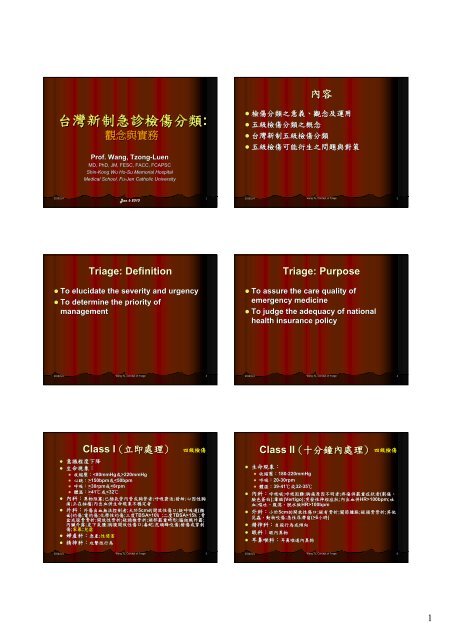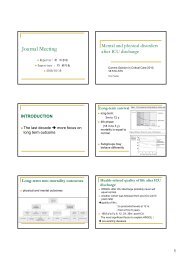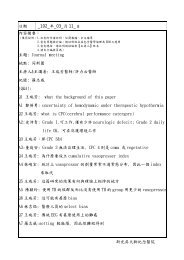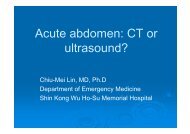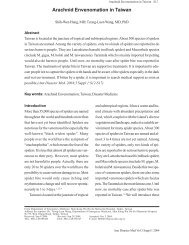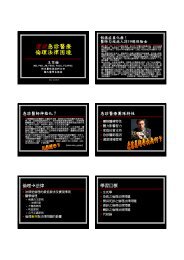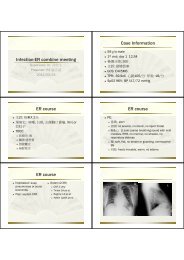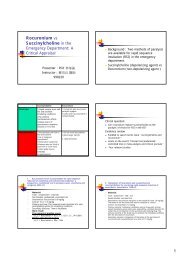Special Lecture
Special Lecture
Special Lecture
- No tags were found...
Create successful ePaper yourself
Turn your PDF publications into a flip-book with our unique Google optimized e-Paper software.
內 容台 灣 新 制 急 診 檢 傷 分 類 :觀 念 與 實 務Prof. Wang, Tzong-LuenMD, PhD, JM, FESC, FACC, FCAPSCShin-Kong Wu Ho-Su Memorial HospitalMedical School, Fu-Jen Catholic University• 檢 傷 分 類 之 意 義 、 觀 念 及 運 用• 五 級 檢 傷 分 類 之 概 念• 台 灣 新 制 五 級 檢 傷 分 類• 五 級 檢 傷 可 能 衍 生 之 問 題 與 對 策Jan 6 20102010/3/4 12010/3/4Wang TL. Concept of Triage 2Triage: DefinitionTriage: Purpose• To elucidate the severity and urgency• To determine the priority ofmanagement• To assure the care quality ofemergency medicine• To judge the adequacy of nationalhealth insurance policy2010/3/4Wang TL. Concept of Triage 32010/3/4Wang TL. Concept of Triage 4Class I ( 立 即 處 理 )四 級 檢 傷• 意 識 程 度 下 降• 生 命 現 象 :• 收 縮 壓 :220mmHg• 心 跳 :>150:150bpm或 30:30rpm或 41:41℃ ℃ 或 1010%; 二 度 TBSA>1515%; 骨盆 或 股 骨 骨 折 ; 開 放 性 骨 折 ; 疑 頸 椎 骨 折 ; 頭 部 嚴 重 畸 形 ; 腦 組 織 外 露 ;內 臟 外 露 ; 皮 下 氣 腫 ; 胸 腹 開 放 性 傷 口 ; 毒 蛇 ; 虎 頭 蜂 咬 傷 ; 槍 傷 或 穿 刺傷 ; 家 暴 ; 兒 虐• 婦 產 科 : 急 產 ; 性 侵 害• 精 神 科 : 攻 擊 性 行 為Class II ( 十 分 鐘 內 處 理 )四 級 檢 傷• 生 命 現 象 :• 收 縮 壓 :180:180-220mmHg• 呼 吸 :20:20-30rpm• 體 溫 :39:39-41℃ ℃ 或 32-3535℃• 內 科 : 呼 吸 喘 ; 呼 吸 困 難 ; 胸 痛 原 因 不 明 者 ; 疼 痛 併 嚴 重 症 狀 者 ( 劇 痛 、臉 色 蒼 白 ); 暈 眩 (Vertigo);突 發 性 神 經 症 狀 ; 內 出 血 併 HR>100bpm; 吐血 ; 嘔 吐 、 腹 瀉 、 脫 水 致 HR>100bpm• 外 科 : 小 於 5cm的 開 放 性 傷 口 ; 疑 有 骨 折 ; 關 節 腫 脹 ; 疑 頭 骨 骨 折 ; 其 他昆 蟲 、 動 物 咬 傷 ; 急 性 尿 滯 留 (>6 小 時 )• 精 神 科 : 自 殺 行 為 或 傾 向• 眼 科 : 眼 內 異 物• 耳 鼻 喉 科 : 耳 鼻 喉 道 內 異 物2010/3/4Wang TL. Concept of Triage 52010/3/4Wang TL. Concept of Triage 61
Class III ( 三 十 分 鐘 內 處 理 )四 級 檢 傷• 生 命 現 象 :• 體 溫 :38:38-39℃• 內 科 : 抽 搐 已 停 止 者 ; 疼 痛 但 無 嚴 重 症 狀 者 ; 頭 暈(dizziness);血 便 、 黑 便 、 咳 血 但 生 命 徵 象 穩 定 者 ; 嘔 吐 、腹 瀉 但 生 命 徵 象 穩 定 者 ; 疑 似 或 輕 微 中 風• 外 科 : 無 傷 口 之 軟 組 織 傷 害 ; 動 物 抓 傷 ; 血 尿 ; 尿 路 結 石 ; 解尿 困 難• 精 神 科 : 失 眠Class IV ( 可 延 後 處 理 )四 級 檢 傷• 不 符 合 急 診 以 上 條 例 , 如 :• 頭 痛 、 喉 痛 、 咳 嗽 、 流 鼻 水 等 感 冒 症 狀 。• 中 風 後 遺 症 。• 中 風 已 數 日 , 在 別 處 已 處 理 過 , 來 本 院 等 住 院 者 。• 已 知 癌 症 的 病 患 , 其 主 訴 顯 然 與 癌 症 有 關 者 , 且 生 命徵 象 正 常 。• 自 門 診 轉 來 做 常 規 檢 查 的 治 療 者 。• 自 門 診 轉 來 等 住 院 者 , 但 生 命 徵 象 正 常 者 。• 主 訴 某 種 症 狀 已 有 相 當 時 日 , 但 生 命 徵 象 正 常 者 。2010/3/4Wang TL. Concept of Triage 72010/3/4Wang TL. Concept of Triage 8Significance of TriageThinking• Is triage just once for each ER patient?• Does the triage provide only the benefitof maximally 30 min difference inpriority of management at the initialstage?Repeated and Dynamic (READ) Triage• Is Traditional Triage Useful for MostCase Scenarios?• Not Definitely• Not work for Pediatric Patients• Not work for Trauma Patients• Individualization is necessary!!2010/3/4Wang TL. Concept of Triage 92010/3/4Wang TL. Concept of Triage 10極 危 險 、 第 一 優 先 ( 紅 色 )2010/3/4大 量 傷 患 分 類(Mass Casualties)Wang TL. Concept of Triage 112010/3/41. 呼 吸 停 止 或 呼 吸 道 阻 塞 。2. 被 目 擊 的 心 臟 停 止 。3. 動 脈 斷 掉 或 無 法 控 制 之 出 血 。4. 穩 定 性 的 頸 部 受 傷 。5. 嚴 重 的 頭 部 受 傷 且 意 識 昏 迷 。6. 開 放 性 胸 部 或 腹 部 傷 害 。7. 大 型 或 併 發 性 燙 傷 。8. 嚴 重 休 克 。9. 呼 吸 道 燙 傷 或 灼 傷 。10. 壓 力 性 氣 胸 。11. 內 科 醫 療 疾 病 的 併 發 症 。12. 關 節 骨 折 且 遠 端 無 脈 搏 。13. 股 骨 骨 折 。Wang TL. Concept of Triage 122
危 險 、 第 二 優 先 ( 黃 色 )1. 背 部 受 傷 ( 不 論 是 否 有 脊 椎 受 傷 ) 。2. 中 度 的 流 血 ( 少 於 二 處 ) 。3. 嚴 重 燙 傷 。4. 開 放 性 或 多 處 骨 折 。5. 穩 定 的 腹 部 傷 害 。6. 眼 部 傷 害 。7. 穩 定 性 的 藥 物 中 毒 。輕 傷 、 最 低 優 先 、 延 後 處 理 ( 綠 色 )1. 小 型 的 挫 傷 或 軟 組 織 傷 害 。2. 小 型 或 簡 單 型 骨 折 。3. 肌 肉 扭 傷 。4. 凡 是 由 於 受 傷 過 於 嚴 重 ( 如 : 頭 部 外 傷 且腦 組 織 外 露 , 三 級 灼 傷 且 超 過 體 表 面 積百 分 之 四 十 以 上 ) 且 存 活 機 會 不 太 大 者 。2010/3/4Wang TL. Concept of Triage 132010/3/4Wang TL. Concept of Triage 14死 亡 ( 黑 色 )1. 頭 部 不 見 。2. 沒 有 脈 搏 超 過 二 十 分 鐘 , 除 了 冷 水 溺水 或 極 度 低 體 溫 者 。3. 軀 幹 分 離 。4. 從 高 度 落 下 且 具 有 多 處 的 受 傷 與 骨折 , 沒 有 呼 吸 者 。5. 肉 臟 外 脫 。Rationale for Mass Casualty Triage• Reverse Triage• START• Rationale:• Effective Use of Limited Resources• Grave Outcome of Traumatic CardiacArrest• Exceptions:• Reverse Reverse Triage• Lightening2010/3/4Wang TL. Concept of Triage 152010/3/4Wang TL. Concept of Triage 16STARTSTART / JumpSTART2010/3/4Wang TL. Concept of Triage 172010/3/4Wang TL. Concept of Triage 183
Is That Enough?Killip Classification• A 43-yearyear-old male with chest pain andcold sweating for 10 minutes, BP130/80, PR 80, RR 18, BT 36.5, SpO297% Triage?• A 43-yearyear-old male with chest pain andcold sweating for 10 minutes, BP 80/50,PR 130, RR 30, BT 35.6, SpO2 86% Triage?2010/3/4Disease Specific Triage (Risk Stratification)Wang TL. Concept of Triage 19• Killip I: Rales and S3 absent• Killip II: Rales over 50% of lungfields (pulmonary edema)• Killip IV: Shock2010/3/4Subset I: Normal hemodynamics; PCWP2.2Subset II: Pulmonary congestion: PCWP>18; CI18; CI>2.2Subset IV: Pulmonary congestion and peripheralhypoperfusion; PCWP>18; CI 55yr• WBC > 16,000/cmm• Glucose > 200 mg/dL• LDH > 350 IU/L• GOT > 250 IU/L• 48 Hours• Hct drop > 10%• PaO2 < 60 mmHg• Ca < 8 mg/dL• Base deficit > 4mEq/L• BUN rise > 5 mg/dL• Estimated fluidsequestration > 6LRanson’s criteria (non-alcoholic)• Admission• Age > 70yr• WBC > 18,000/cmm• Glucose > 220 mg/dL• LDH > 400 IU/L• GOT > 440 IU/L• 48 Hours• Hct drop > 10%• PaO2 < 60 mmHg• Ca < 8 mg/dL• Base deficit > 5mEq/L• BUN rise > 2 mg/dL• Estimated fluidsequestration > 6L2010/3/4Wang TL. Concept of Triage 212010/3/4Wang TL. Concept of Triage 22Prediction Model forPneumoniaPrediction Model forPneumoniaPatient characteristic Points assigned_______________Demographic factorsAge:o Males:Age (in years)o Females: Age (in years) -10Nursing home resident: +10Comorbid illnessesNeoplastic disease: +30Liver disease: +20Congestive heart failure: +10Cerebrovascular disease: +10Renal disease: +10Physical examination findingsAltered mental status: +20Respiratory rate 30/minuteor more: +20Systolic blood pressure
2010/3/4Prediction Model forPneumoniaLaboratory findingspH 10.7 mmol/L: +20Sodium 13.9 mmol/L: +10Hematocrit 5.0mg/dL (1 point)• activated partial prothrombin time> 40sec (1 point)SSSS > 6 probable SARSConclusion• Triage is Risk Stratification!• Triage is Dynamic and Continuous!• Disease-Specific Triage (RiskStratification) is Indicated!• The first year emergency residencytraining should be focused upon Triage!2010/3/4Wang TL. Concept of Triage 272010/3/4Wang TL. Concept of Triage 28Classification of Triage5-Tier Triage• 2-level, 3-level, 34-level 4and 5-level 5triage• Triage/Acuity/Diversion• CTAS (Canadian Triage and Acuity Scale)• Acuity/Resource• ESI (Emergency Severity Index)2010/3/4 292010/3/4Wang TL. Concept of Triage 305
Classification of Triage• 2-level, 3-level, 34-level 4and 5-level 5triageClassification of Triage• 5-tier triage2010/3/4Wang TL. Concept of Triage 312010/3/4Wang TL. Concept of Triage 32Example• Canadian Triage Acuity Scale (CTAS)• Level 1 – Resuscitation: Any child or infant who requirescontinuous assessment and intervention to maintainphysiological stability• Level 2 – Emergent: Any physiologically unstable child.Dehydration is difficult to accurately assess. Any suspicion(or evidence) should cause concern.• Level 3 – Urgent: Child or infant who is alert, oriented, wellhydrated, minor alterations in vital signs.• Level 4 – Less Urgent: Alert child with fever and simplecomplaints such as ear pain, sore throat, or nasalcongestion.• Level 5 – Nonurgent: : Alert child who is afebrile, , wellhydrated w/ normal vital signsExample• Pediatric Canadian Triage Acuity Scale (Paed(CTAS)2010/3/4Wang TL. Concept of Triage 332010/3/4Wang TL. Concept of Triage 34Example• Pediatric CanadianTriage Acuity Scale(PaedCTAS)ExampleEmergency Severity Index (ESI)2010/3/4Wang TL. Concept of Triage 352010/3/4Wang TL. Concept of Triage 366
Taiwan 5-Tier 5Triage• Conducted by Taiwan Society ofEmergency Medicine under grant fromDepartment of Health• Implemented on Jan 1st 2010• Combined with payment from NationalInsurance Council• Electronic Processing AssistanceTaiwan 5-Tier 5Triage• TTAS 5 (Taiwan Triage and AcuityScale 5)• Standardization• Find the right patients• Avoid under- or over-triage• Ensure patient safety and resource utilization• Establish reliable database and statistics• Software demonstration2010/3/4Wang TL. Concept of Triage 372010/3/4Wang TL. Concept of Triage 38TTAS 檢 傷 級 數TTAS 檢 傷 級 數2010/3/4Wang TL. Concept of Triage 392010/3/4Wang TL. Concept of Triage 40TTAS 檢 傷 級 數TTAS 檢 傷 級 數2010/3/4Wang TL. Concept of Triage 412010/3/4Wang TL. Concept of Triage 427
Case 2Case 2• Those who lack adequatecompensation mechanisms• Known sympathovagal imbalance• Diabetes: sympathovagal imbalance• Drugs: Beta-adrenergic adrenergic agents• Extreme elderly• Pacemaker for symptomatic bradycardia• Heart transplant recipients2010/3/4Wang TL. Concept of Triage 612010/3/4Wang TL. Concept of Triage 62Case 2• Those who have too goodcompensation mechanisms• Little kids• AthleteBPTriage Decision Scheme(Trauma)• STEP 1: Measure Vital Signs and Levelof Consciousness• GCS20 inches (50cm)• Extrication time > 20 minutes• Ejection (partial or complete) from auto• Death in same passenger compartment• Vehicle telemetry data consistent with high risk of injury(Initial speed >40mph (64 kph))• Auto vs. Pedestrian / bicyclist thrown, run over, or withsignificant (>20 mph) impact• Auto-pedestrian injury with > 5mph (8kph) impact• Motorcycle crash > 20 mph (32 kph) ) or with separation ofrider and bike2010/3/4Wang TL. Concept of Triage 652010/3/4Wang TL. Concept of Triage 6611
Triage Decision Scheme• STEP 4: <strong>Special</strong> Patient or System Considerations• Age• Older adults: Risk of injury / death increases after age 55• Children: Should be triaged preferentially to pediatric-capablecapabletrauma centers (20 wks• EMS provider judgment• End-stage renal disease requiring dialysis• Immunosuppressed patients• Cardiac disease; respiratory disease• Insulin-dependent diabetes; cirrhosis; morbid obesityCase 3• A 26-yearyear-old female has found fallingdown 20 minutes ago. She regainedconsciousness 3 minutes later.• Vital signs: BP 120/68, PR 62, RR 20, BT35.8, SpO2 98% GCS E4M6V5• PMH: PID/leukorrheaunder treatment2010/3/4Wang TL. Concept of Triage 672010/3/4Wang TL. Concept of Triage 68Case 3Case 3Type of LQTSChromosomalLocusMutated GeneIon CurrentAffected• Long QT syndrome(LQTS)LQT1LQT2LQT3LQT411p15.57q35-363p21-244q25-27KVLQT1, or KCNQ1(heterozygotes)HERG, KCNH2SCN5AANK2, ANKBPotassium (I Ks )Potassium (I Kr )Sodium (I Na )Sodium, potassiumand calciumLQT521q22.1-22.2KCNE1(heterozygotes)Potassium (I Ks )LQT621q22.1-22.2MiRP1, KNCE2Potassium (I Kr )LQT7(Andersonsyndrome)17q23.1-q24.2KCNJ2Potassium (I K1 )LQT8 (Timothysyndrome)12q13.3CACNA1CCalcium (I Ca-Lalpha )LQT93p25.3CAV3Sodium (I Na )LQT1011q23.3SCN4BSodium (I Na )LQT117q21-q22AKAP9Potassium (I Ks )LQT12SNTAISodium (I Na )JLN111p15.5KVLQT1, or KCNQ1(homozygotes)Potassium (I Ks )2010/3/4Wang TL. Concept of Triage 692010/3/4JLN221q22.1-22.2 KCNE1 (homozygotes) Potassium (I Ks )Wang TL. Concept of Triage 70Case 3Case 3• Acquired long QT• Antibiotics• Antidepressants• Antifungals• Antihistamines• Diuretics• Heart medications• Lipid-lowering medications• Oral hypoglycemics (for diabetes)• Psychotropic medications• Medications that triggers TdP in inheritedLQTS• Appetite suppressants• Bronchodilators• Catecholamines• Certain common antibiotics (e.g., erythromycin)• Decongestants• Uterine relaxants• Vasoconstrictors2010/3/4Wang TL. Concept of Triage 712010/3/4Wang TL. Concept of Triage 7212
Case 3• Conscious Change• GCS 14-1515 TTAS Triage III-V• GCS 9-139 TTAS Triage II• GCS 3-83 TTAS Triage I• Syncope right now or just before• Always implicates Triage I• TTAS Triage III-V V (can be modified as Triage I)Case 4• A 45-yearyear-old male complains of chestpain and cold sweating for 30 minutes• Vital signs: BP 140/82, PR 80, RR 18, BT36.5, SpO2 97% GCS E4M6V5• PMH: smoking2010/3/4Wang TL. Concept of Triage 732010/3/4Wang TL. Concept of Triage 74Case 4Case 42010/3/4Wang TL. Concept of Triage 752010/3/4Wang TL. Concept of Triage 76Circulation 2005;112:IV-89-IV-110Options for Transport of Patients WithSTEMI and Initial Reperfusion TreatmentOnset of 9-1-1 EMS on-scenesymptoms of EMS • Encourage 12-lead ECGs.STEMI Dispatch • Consider prehospital fibrinolytic ifcapable and EMS-to-needle within30 min.GOALS5 8min. EMS Transportmin.Patient EMS Prehospital fibrinolysisEMS transportEMS-to-needlewithin 30 min.Dispatch1 min.Golden Hour = first 60 min.EMSTriagePlanEMS-to-balloon within 90 min.Patient self-transportHospital door-to-balloonwithin 90 min.within 30 min.Not PCIcapablePCIcapableTotal ischemic time: within 120 min.Hospital fibrinolysis:Door-to-NeedleInter-HospitalTransferAntman EM, et al. J Am Coll Cardiol 2008. Published ahead of print on December 10, 2007. Available at2010/3/4Wang TL. Concept of Triage http://content.onlinejacc.org/cgi/content/full/j.jacc.2007.10.001. Figure 1.772010/3/4Case 4• Role of Emergency Physician on STEMI• Prompt and Correct Diagnosis• Atypical presentations: DM, Female, Elderly,medical modifications• Unusual ECG findings: hyperacute T, BBB• Successful Resuscitation for WitnessedVF/VT (Cardiac Arrest)• Peak of VF/VT vs. AMI• Always implicates Triage I• TTAS Triage II (can be modified as Triage I)Wang TL. Concept of Triage 7813
Case 4• Role of Cold Sweating• Excess Activation of Sympathetic Tone• Extreme Physical Stress• Atypical Presentations: Masking byUnderlying Conditions or Medications• Always implicates Triage I• TTAS Triage II (can be modified as Triage I)Case 5• A 60-yearyear-old female complains suddenonset of epigastralgia 30 minutes ago• Vital signs: BP 126/74, PR 75, RR 22, BT36.3, SpO2 95% GCS E4M6V5• PMH: diabetes under OHA for 7 years2010/3/4Wang TL. Concept of Triage 792010/3/4Wang TL. Concept of Triage 80Case 5Case 5• Unusual presentations• Sudden onset• Severe symptoms that never experienced• Extreme gaps between symptoms and signs• Sense of dying (or end of the world)• Illusion or hallucination of ghosts / gods• Esp. in• those with atypical presentations• Low socio-economic status or special culturebackground2010/3/4Wang TL. Concept of Triage 812010/3/4Wang TL. Concept of Triage 82Case 6Case 6• A 25-yearyear-old female complains gradualonset of headache and generalweakness for 1 hour. She found her catalso sick.• Vital signs: BP 98/54, PR 98, RR 22, BT36.3, SpO2 98% GCS E4M6V5• PMH: Nil• Limitations for Pulse Oximetry• motion artifact• abnormal hemoglobins (primarily carboxyhemoglobin[COHb]] and met-hemoglobin [metHb[metHb])• intravascular dyes• exposure of measuring probe to ambient light duringmeasurement• low perfusion states• skin pigmentation• nail polish or nail coverings with finger probe• inability to detect saturations below 83% with the samedegree of accuracy and precision seen at higher saturations• inability to quantitate the degree of hyperoxemia present• Hyperbilirubinemia has been shown NOT to affect theaccuracy of SpO2 readings2010/3/4Wang TL. Concept of Triage 832010/3/4Wang TL. Concept of Triage 8414
Case 6• Hypoxia• Hypoxemia (reduced arterial oxygen content)a. Reduced PaO2b. Reduced SaO2c. Reduced hemoglobin content (anemia)• Reduced oxygen deliverya. Reduced cardiac outputb. Left-toto-rightsystemic shunt (e.g., septic shock)• Decreased tissue oxygen uptakea. Mitochondrial poisoning (e.g., cyanide)b. Left-shiftedhemoglobin dissociation curve (e.g.,abnormal hemoglobin structure)Case 7• A 68-yearyear-old male was noted to haveacute onset of right-sided weaknessand speech difficulty 45 minutes ago.• Vital signs: BP 170/122, PR 64, RR 22,BT 36.0’C, SpO2 96% GCS E4M6V5• PMH: Nil2010/3/4Wang TL. Concept of Triage 852010/3/4Wang TL. Concept of Triage 86Case 7Case 8Seven D’s• A 21-yearyear-old female complains suddenonset of severe headache (grade 10/10)for 1 hour.• Vital signs: BP 140/96, PR 70, RR 24, BT36.5’C, SpO2 98% GCS E4M6V5• PMH: Nil2010/3/4Wang TL. Concept of Triage 872010/3/4Wang TL. Concept of Triage 88Circulation 2005;112:IV-111-IV-120Case 8Case 8Pain Scale is UsuallyUnder-estimated!2010/3/4Wang TL. Concept of Triage 892010/3/4Wang TL. Concept of Triage 9015
Case 8• Life-Threatening Pain• AMI, DAA, PE, Cardiac Tamponade, , TensionPneumothorax, , Esophageal Rupture• Hollow organ perforation, SMA Occlusion, InternalHernia• Necrotizing Fasciitis• SAH• Organ-Threatening Pain• Glaucoma• PAODCase 9• A 45-yearyear-old female was injured by herhusband 1 hour ago. Multiple bruisingover her trunk and left forearmdeformity were noted.• Vital signs: BP 122/68, PR 95, RR 22, BT35.6’C, SpO2 98% GCS E4M6V5• PMH: Nil2010/3/4Wang TL. Concept of Triage 912010/3/4Wang TL. Concept of Triage 92Case 9Case 9• Social Indication as Triage I• Domestic Violence• Child Abuse• Sexual Assault• Attempted Homicide• Highly Clinical Suspicion• Usually Under-triaged• Child Abuse• Screening• More than 3 episodes of trauma from EDrecordings• Inconsistent medical history• Inconsistence between history and physicalfindings• Delayed transportation / consultation• Any fracture or head injury for those < 1y2010/3/4Wang TL. Concept of Triage 932010/3/4Wang TL. Concept of Triage 94Case 9Case 9• Child Abuse• Physical Findings2010/3/4• Skin: Blunt Injury, Burn, Bite• Face: Raccoon Eye, ENT, Teeth, Lip, Hair• Head: Abusive Head Injury, Shaken Baby• Abdomen: Liver Laceration, DuodenalHematoma, , Traumatic Pancreatitis, , MesenteryLaceration• Fracture:• Much younger; Multiple; Varying stages; Spiral orOblique• Eg: : post. ribs; scapula; sternum; complex skullWang TL. Concept of Triage 95• Child Abuse• High Specificity (for example)2010/3/4• Metaphyseal fractures• Rib fractures• Scapular fractures• Fractures of the outer end of the clavicle• Fractures of differing ages• Vertebral fractures or subluxation• Digital injuries in non-mobile children• Bilateral skull fractures• Complex skull fracturesWang TL. Concept of Triage 9616
Case 10Case 10• A 70-yearyear-old patient was transferred toour ED under the diagnosis of ACS. Hispresent chief complaint is SOB formore than 2 days (R1 recorded). Heconsulted another ED and has gottenthe treatment of Clexane for 2 days.• BP 136/72, PR 100/min, RR 18/min,SpO2 97%, GCS E4M6V5• PMH: Hypertension2010/3/4Wang TL. Concept of Triage 972010/3/4Wang TL. Concept of Triage 98Case 10Case 10• MONA• ECG Monitoring• Continue Bokey, Clexane• Review his history, sudden-onsetunexperienced chest pain that radiatedfrom anterior chest to middle back withcold sweating was noted initially 3 daysago.2010/3/4Wang TL. Concept of Triage 992010/3/4Wang TL. Concept of Triage 100Case 10Case 10Crescent Sign2010/3/4Wang TL. Concept of Triage 1012010/3/4Wang TL. Concept of Triage 10217
Case 10• Inter-Hospital Transfer• Usually treated as Triage I• Over-triage rather than Under-triage• Complete history taking• From the very beginning• Chief complaint at the 1st visit• Complete exclusion or NOT• Life-threatening chest pain• ACS• DAA• PE• Tension pneumothorax• Cardiac tamponade• Esophageal ruptureCase 11• A 63-yearyear-old male suffered fromsudden onset of left eye blindness.• BP 158/92, PR 84/min, RR 20/min, SpO296%, GCS E4M6V5• PMH: DM and Hypertension for 10years2010/3/4Wang TL. Concept of Triage 1032010/3/4Wang TL. Concept of Triage 1042010/3/4Case 11• Amaurosis Fugax• Embolic and hemodynamic origin• Atherosclerotic carotid artery• Atherosclerotic ophthalmic artery• Cardiac emboli due to (1) atrial fibrillation, (2) valvular abnormalities includingpost-rheumatic valvular disease, mitral valve prolapse, and a bicuspid aorticvalve, and (3) atrial myxomas.• Temporary vasospasm• Giant cell arteritis• Systemic lupus erythematosus• Periarteritis nodosa• Eosinophilic vasculitis• Hyperviscosity syndrome• Polycythemia• Hypercoagulability• Protein C deficiency• Antiphospholipid antibodies• Anticardiolipin antibodies• Lupus anticoagulant• Thrombocytosis• Subclavian steal syndrome• Malignant hypertension• Drug abuse-related intravascular emboli• IatrogenicWang TL. Concept of Triage 1052010/3/4Case 11• Amaurosis Fugax• Occular origin• Iritis• Keratitis• Blepharitis• Optic disc drusen• Posterior vitreous detachment• Closed-angle glaucoma• Transient elevation of intraocular pressure• Intraocular hemorrhage• Coloboma• Myopia• Orbital hemangioma• Orbital osteoma• Keratoconjunctivitis sicca• Neurological origin• Optic neuritis• Compressive optic neuropathies• Papilledema• Multiple Sclerosis• Migraine• Pseudotumor cerebri• Intracranial tumor• PsychogenicWang TL. Concept of Triage 106Case 12Asthma Severity• A 12-yearyear-old boy was sent to ED dueto progressive dyspnea for severalhours. He was just discharged 1 weekago after successful extubation.• BP 110/66, PR 120/min, RR 28/min,SpO2 92%, GCS E4M6V5. No wheezing• PMH: Asthma2010/3/4Wang TL. Concept of Triage 1072010/3/4Wang TL. Concept of Triage 10818
Asthma SeverityFactor Severe asthma (FEV 1 20, thereforenondiscriminating≥10, but may be absent with equallysevere asthma in 50% of casesIf all three abnormal, 90% withsevere asthma, but only 40% withFEV 12 MDI short-acting β 2agonist canisters per month8. Current use of or recent withdrawal from systemiccorticosteroids9. Difficulty perceiving severity of airflow obstruction10. Comorbidities such as cardiovascular diseases or othersystemic problems11. Serious psychiatric disease or psychosocial problems12. Illicit drug use, especially inhaled cocaine and heroin2010/3/4Wang TL. Concept of Triage 1092010/3/4Wang TL. Concept of Triage 1105-Tier READ Triage• TTAS by Triage Nurses• Can modify according to clinical judgment• Re-triage by Emergency Physicians• Register in HIS system• 1st re-triage should NOT be lower than TTAS• Dynamic Triage: (color codes as internationallydesigned)• Triage I: Red• Triage II: Orange• Triage III: Yellow• Triage IV: Green• Triage V: Blue• Changing Triage should be treated as an Order!2010/3/4Wang TL. Concept of Triage 1112010/3/4Wang TL. Concept of Triage 11219


